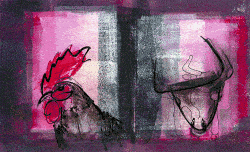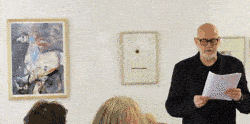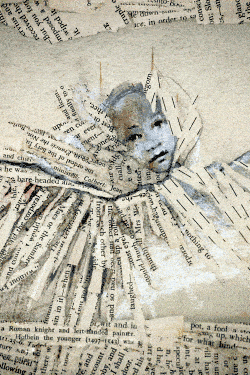“Getting lost,” wrote Rebecca Solnit in her Field Guide To Getting Lost, is “not about geography, but identity, an urgent need to become no-one and anyone.” It is a paradox which lies at the heart of Digressions, Leeds-based poet Ian Duhig’s tripartite (“that’s poetry, art and prose”) collaboration with artist and printmaker Philippa Troutman. Taking as its start point, Laurence Sterne’s enduring 18th century picaresque masterpiece The Life and Opinions of Tristram Shandy, Gentleman, the project commenced in 2013 – the tercentenary year of the writer’s birth – and culminated recently with the publication of a book, a series of poetry readings and an exhibition at Shandy Hall, Sterne’s rambling former residence at Coxwold in North Yorkshire.
“Tristram Shandy sets up a series of paradoxes,” says Ian Duhig when we meet to discuss the project, “not least that Sterne described what he was doing as painting.” Having already worked with musicians, Duhig was curious to repeat the experience with a visual artist. “The relationship with words and pictures was mysterious to me,” he explains. The decision to involve Philippa Troutman, with whom the poet enjoys a long and close friendship, was an obvious first step, enabling Digressions “to explore the productive borderland between art and literature.” When he speaks of wanting to set up a kind of artist’s mirror, in order to explode the creative correspondences which might be made available, there is a sense that Duhig is invoking his hero, the poet Wallace Stevens, who suggested, “The problems of poets are the problems of painters, and poets must often turn to the literature of painting for a discussion of their own problems.
The collaboration between Duhig and Troutman proved extremely fruitful. “We originally planned to put together a pamphlet, but we discovered more and more,” Ian laughs. “In the end we published a 64 page book that could easily have run to another thirty pages.” For the artist too, the project took an unexpected turn. “For years I have made small, intimate black and white pieces,” says Philippa Troutman. “I’ve reintroduced colour and scale in response to Ian’s words. It was exciting and risky.” It was Troutman who pursued the use of cut-ups (situationist poet Tristan Tzara sounding not dissimilar to Tristram Shandy), as well as introducing Duhig to the happy accident in printmaking known as ‘foul bite’ (where acid used in the process bleeds unpredictably, creating an unintentionally striking effect).
The two were struck by the back to front, counter-intuitive discipline of print-making which they felt chimed perfectly with the meticulously conceived haphazardness of Tristram Shandy. The pair undertook a series of sideways excursions around Shandy Hall, their off-kilter trajectories being governed by such loose-leaf coordinates that they brought to light improbable synergies. “Although we had plans, some things were marvellous, accidental discoveries,” Ian says of the experience. Driving around one day in search of the City of Troy, a turf maze local to the area, poet and artist were captivated by a bird of prey – a merlin – which suddenly appeared and hovered before them, as if out of nowhere. This image finds expression in a number of the final prints made for the accompanying exhibition, the rich detailing of the bird’s markings echoing the meandering contortions of the sought-after maze itself.
The maze is an apt metaphor: Tristram Shandy is notoriously labyrinthine in its construction and richly allusive in tone and style. “I think it is one of the most important books in English literature,” says Duhig. “I read it as a young man at university, and was captivated. But it was totally off curriculum. Nobody really knew what to make of it.” The book is incredibly difficult to categorise, bearing little resemblance to any other novels at the time of – or, indeed, since – publication. (In his biography of Dr Johnson, James Boswell recounts a conversation between the two men in which they dismissively opine of Tristram Shandy that “nothing odd will do long.”) Part of the perceived difficulty with Sterne’s ‘odd’ book might be said to lie in the author’s playful, but deliberate, incorporation of typographical and visual devices within the book. “Is it the first hypertext?” muses Ian thoughtfully.
What is clear is that Sterne held resolute notions about how his work should be represented. In her research, Troutman came across highly specific instructions from the author stipulating how his novel was to be typeset using Centro Serif Pro. The discovery led to the artist using the self same typeface in her sketches and ink drawings, punctuating them with a series of bold pointillist marks like some ticker-tape of the subconscious. These Braille-like outpourings, stretching backwards through history, resonated with, what Duhig describes as, his ‘anti-self’, a blind road builder (and near contemporary of Sterne) named Jack Metcalfe, who constructed the road to Ripon – in the general direction of Shandy Hall – from Leeds. “He would measure pebbles and stones by rolling them around inside his mouth,” Ian explains, “which, to me as a poet, seems an ideal way to describe the act of finding the words to fit the purpose of a poem.”
The paradox of a blind man constructing a straight road brings us back full circle (paradoxically), marking both the beginning and the end of our journey. Duhig describes an architect’s exercise where students are asked to write their signature on a map of a city, and are then asked to walk the route they have laid down. “It begins with the familiarity of your own name,” he explains, “but when you then walk it, you make discoveries about the city, and also yourself.” It seems too good a metaphor to ignore. The original intention behind Duhig’s and Troutman’s work might well have been to celebrate Tristram Shandy, and to publicise the work being done at Shandy Hall to champion contemporary writing, but the book’s enduring and continuing contribution to the culture has also left its indelible signature on Digressions.
Images of prints used by kind permission of Philippa Troutman.
Digressions is published by Smokestack Books and available to buy online.
Some more of Philippa Troutman’s prints for the project can be found here.
Ian Duhig has written a more fulsome account of the Digressions journey here.


